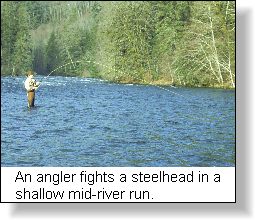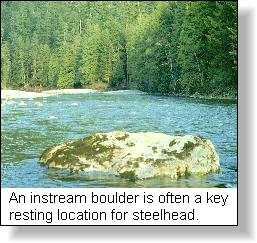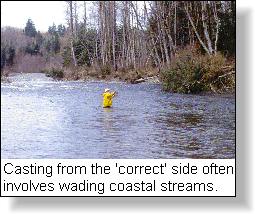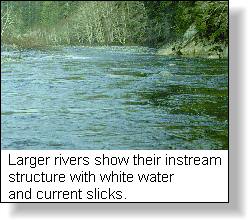
Steelhead Fishing Series
"Steelhead Fishing a New River"
Part 2: Factors to Consider
with Barry M. Thornton
 When I steelhead on a new river or, walk the banks of an old friend that
I haven't visited for a long while, I consider a number of factors before
even casting. These elements, the critical factors for success include water
color, pools and riffles; streamside canopy; size of river; dominant riverbed
material; known historic fishery; access routes and hatchery introductions.
In my last article I discussed the color of
the water and how it affects my decisions for reading water, fly patterns,
lures and casting for steelhead. In this second part I will look at some
other critical factors involved in successfully fishing new streams for
winter steelhead.
Seasonal Window:
 Every stream has an unique race of winter steelhead
that has evolved site specific to that river's special conditions. These
conditions include water flow, gradient, stream length, spawning gravel,
and tributary mix, just to name a few. As a result of these unique conditions,
winter steelhead have evolved since the last ice age (during the last
12,000 years) to enter their home rivers at optimum times which will
ensure the survival of the eggs, alevins and fry in those special river
conditions. This is the 'seasonal spawning window' for the river. We
can generalize for most rivers by saying that this 'window' starts early
in December and concludes in April. We can even be more specific by
saying, that while winter steelhead runs begin in December, rivers without
a major lake at their headwater will have later runs, a longer window,
which may extend well into May, and, in some cases, even into June. Every stream has an unique race of winter steelhead
that has evolved site specific to that river's special conditions. These
conditions include water flow, gradient, stream length, spawning gravel,
and tributary mix, just to name a few. As a result of these unique conditions,
winter steelhead have evolved since the last ice age (during the last
12,000 years) to enter their home rivers at optimum times which will
ensure the survival of the eggs, alevins and fry in those special river
conditions. This is the 'seasonal spawning window' for the river. We
can generalize for most rivers by saying that this 'window' starts early
in December and concludes in April. We can even be more specific by
saying, that while winter steelhead runs begin in December, rivers without
a major lake at their headwater will have later runs, a longer window,
which may extend well into May, and, in some cases, even into June.
For the steelheader this seasonal spawning window is crucial for it can
be used to determine and plan your winter angling trips. This information
is now well documented for almost all B.C. rivers and is available at Provincial
Fisheries offices. It is also available from experienced steelheaders -
if they are willing to share what may have taken a lifetime to learn.
Run Peaks:
 While there is a variable seasonal spawning window for winter steelhead,
every stream has historic peak runs. Often these 'run peaks' can be
generalized to the months of December, February, March and April. However,
my experience has shown me that not all rivers follow this general timing.
In fact it appears that most rivers usually have only three 'run peaks'.
These 'run peaks' are also know to fisheries. In the early part of the
season, the 'peaks' are dependent upon storms hence they cannot be defined
as occurring on a specific date. Rather, they will occur immediately
following a seasonal storm in a two to three week time period. On the
other hand, late in the season, warm rain water and snow pack melt will
have fresh winter steelhead entering their river every day. While there is a variable seasonal spawning window for winter steelhead,
every stream has historic peak runs. Often these 'run peaks' can be
generalized to the months of December, February, March and April. However,
my experience has shown me that not all rivers follow this general timing.
In fact it appears that most rivers usually have only three 'run peaks'.
These 'run peaks' are also know to fisheries. In the early part of the
season, the 'peaks' are dependent upon storms hence they cannot be defined
as occurring on a specific date. Rather, they will occur immediately
following a seasonal storm in a two to three week time period. On the
other hand, late in the season, warm rain water and snow pack melt will
have fresh winter steelhead entering their river every day.
Hatchery Steelhead or "Urban Steelhead"
The introduction of hatchery steelhead in specific streams has created
a new dimension to the 'when' to fish those streams. These 'urban steelhead'
have specific return times which are usually well known. Fisheries is your
best source of information as are local sporting goods stores.
Stream Canopy
Streams can usually be divided into those that have dense streambank
vegetation, often in the form of an overhanging canopy, and, those that
have extensive gravel beaches. The former are difficult to fly fish unless
the angler is a master with the roll cast, while the latter is the fly fisher's
dream water. On the other hand those anglers fishing with floats or drift
fishing have a decided higher success ratio than the fly fisher for they
are able to cast to preferred resting pools under the
overhanging canopy.
Steelhead have holding preferences in each type of stream. For streams
with thick streambank vegetation, steelhead will hold in any water that
gives them cover; sometimes even very shallow runs. Pools are the natural
holding water but all anglers should also spend time casting in the riffle
sections that look like they will hold fish. If there is a large boulder
in the riffles make certain that you cast above the boulder and let your
lure drift through the side slicks on either side. This is preferred steelhead
holding water.
For streams with open banks and extensive gravel beaches all steelheaders
should concentrate on the tailout section of defined pools. As well, deep
water pockets in riffle sections, usually obvious by deeper colored water,
should also be fished. However, regardless of which kind of stream I am
fishing I still work on the principle that 60% of steelhead will lie in
the pool tailout; 20% will lie at the pool headwaters; and 20% will rest
in the main pool area.
Holding Locations
 Over the years, as rivers have changed their banks and locations,
I have noted that tides and the amount of daylight have dictated the
general location where winter steelhead will hold in streams. In fact,
even when the river has created a new course I have discovered that
winter steelhead will hold in locations near where they held during
previous years in old riverbeds. These pools are often referred to as
the 'meat holes' and they are easy to locate by the 'ornaments', (various
lures) hanging on the tree branches on the far side of the pool. Don't
ignore these pools if you are new on the river as they are certain areas
where you will find steelhead. Over the years, as rivers have changed their banks and locations,
I have noted that tides and the amount of daylight have dictated the
general location where winter steelhead will hold in streams. In fact,
even when the river has created a new course I have discovered that
winter steelhead will hold in locations near where they held during
previous years in old riverbeds. These pools are often referred to as
the 'meat holes' and they are easy to locate by the 'ornaments', (various
lures) hanging on the tree branches on the far side of the pool. Don't
ignore these pools if you are new on the river as they are certain areas
where you will find steelhead.
Winter steelheading is without question the closest angling we have to hunting.
Most steelheaders will agree that steelhead are easy to catch once they
have been located. The secret to regular success lies in learning to read
river water and the clues the river gives. Success is also dependent upon
doing your homework; seek out those sources with current information and
capitalize on their advise.
© Copyright Barry M. Thornton
Barry M. Thornton
|





 Every stream has an unique race of winter
Every stream has an unique race of winter  While there is a variable seasonal spawning window for winter steelhead,
every stream has historic peak runs. Often these 'run peaks' can be
generalized to the months of December, February, March and April. However,
my experience has shown me that not all rivers follow this general timing.
In fact it appears that most rivers usually have only three 'run peaks'.
These 'run peaks' are also know to fisheries. In the early part of the
season, the 'peaks' are dependent upon storms hence they cannot be defined
as occurring on a specific date. Rather, they will occur immediately
following a seasonal storm in a two to three week time period. On the
other hand, late in the season, warm rain water and snow pack melt will
have fresh winter steelhead entering their river every day.
While there is a variable seasonal spawning window for winter steelhead,
every stream has historic peak runs. Often these 'run peaks' can be
generalized to the months of December, February, March and April. However,
my experience has shown me that not all rivers follow this general timing.
In fact it appears that most rivers usually have only three 'run peaks'.
These 'run peaks' are also know to fisheries. In the early part of the
season, the 'peaks' are dependent upon storms hence they cannot be defined
as occurring on a specific date. Rather, they will occur immediately
following a seasonal storm in a two to three week time period. On the
other hand, late in the season, warm rain water and snow pack melt will
have fresh winter steelhead entering their river every day. Over the years, as rivers have changed their banks and locations,
I have noted that tides and the amount of daylight have dictated the
general location where winter steelhead will hold in streams. In fact,
even when the river has created a new course I have discovered that
winter steelhead will hold in locations near where they held during
previous years in old riverbeds. These pools are often referred to as
the 'meat holes' and they are easy to locate by the 'ornaments', (various
lures) hanging on the tree branches on the far side of the pool. Don't
ignore these pools if you are new on the river as they are certain areas
where you will find steelhead.
Over the years, as rivers have changed their banks and locations,
I have noted that tides and the amount of daylight have dictated the
general location where winter steelhead will hold in streams. In fact,
even when the river has created a new course I have discovered that
winter steelhead will hold in locations near where they held during
previous years in old riverbeds. These pools are often referred to as
the 'meat holes' and they are easy to locate by the 'ornaments', (various
lures) hanging on the tree branches on the far side of the pool. Don't
ignore these pools if you are new on the river as they are certain areas
where you will find steelhead.